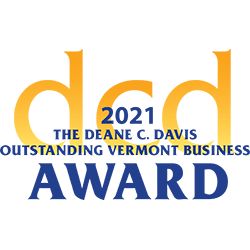Healthy Living Cheese Department Visits Orb Weaver Farm
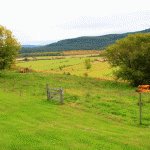
On a cloudy and warm fall day, our entire cheese department, plus store owner Katy Lesser and our store merchandiser, rolled down to New Haven, Vermont, for a rare and sublime visit with the owners of Orb Weaver Farm: Marjorie Susman and Marian Pollack. We were greeted by the women, their two Rhodesian Ridgebacks- Utani and Zuri- and views of their beautiful 100-acre farm. Wasting no time, we were shown into their hoophouse which was full of the biggest shallots any of us had ever seen (shallots which Frank Pace, our meat department manager, buys for our house-made sausages.)

As we made our way to their vegetable garden, Marjorie and Marian shared their history with us, and we marveled to hear that these thirty-year veteran cheesemakers, who were the first commercial farmhouse cheesemakers in Vermont, began with practically no farming knowledge whatsoever; they came to Vermont from Massachusetts in 1980 in response to a dairying job ad. In 1981, they moved on to Mad Maggie Farm (soon to be theirs), attended a cheesemaking class with Ricky Carroll, and Orb Weaver Farm was born. For 14 years, most of the labor went into shipping the milk produced by their thirty Jersey cows and making cheese, but eventually they realized something had to give. So, selling all but four of their cows, they focused on a two-season system, still in place today, where cheese is made from November through May and vegetables and fruits are produced during the growing months in between. During these years, the tenant house was slowly transformed piece by piece into the picturesque farmhouse we visited. Nowadays, with their 14th generation of cows, they produce cheese from seven cows, are starting to get in to the beef business with a few more, and maintain two “pet” cows who are old but loved anyway.
 We made our way to their vegetable gardens, which they call the “summer farm”, stopping in their impressive flower patches which are grown just for their own, and friends’, pleasure. As we admired and discussed them, Utani joined us and plopped down between the tomatoes and flowers; we’re told by the women that both dogs love to snack on fresh bell peppers and Utani is most likely waiting for her opportunity to do just that.
We made our way to their vegetable gardens, which they call the “summer farm”, stopping in their impressive flower patches which are grown just for their own, and friends’, pleasure. As we admired and discussed them, Utani joined us and plopped down between the tomatoes and flowers; we’re told by the women that both dogs love to snack on fresh bell peppers and Utani is most likely waiting for her opportunity to do just that. 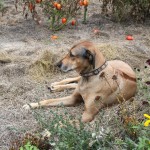
Marjorie and Marian focus on only about seven crops in their gardens, including lettuce, bell and hot peppers, eggplants, tomatoes, broccoli, corn, and carrots. These are sold to select locations, including the Middlebury Co-op, with whom they have an incredibly strong relationship, and nearby restaurants. Only about 2-3 acres total are devoted to their gardens in order to keep it at a manageable scale, Marjorie explains. While in the gardens, we’re introduced to their friend Lauren, a woman who helps out a couple days a week during the gardening months; on that day, she was weeding in the lettuce beds, and they looked pristine.
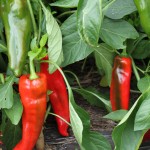 On our way to “the winter farm” (i.e. the cheesemaking operation), we passed by a small garden dedicated to produce grown for their own consumption, as well as several beds full of those delicious peppers loved by humans and dogs alike (and yes, Utani and Zuri did indeed munch on a couple while we were there.) Before looking into the cheese buildings, Marjorie and Marian couldn’t resist showing off the previous evening’s work: a hay barn half-full of the sweetest smelling hay you could imagine.
On our way to “the winter farm” (i.e. the cheesemaking operation), we passed by a small garden dedicated to produce grown for their own consumption, as well as several beds full of those delicious peppers loved by humans and dogs alike (and yes, Utani and Zuri did indeed munch on a couple while we were there.) Before looking into the cheese buildings, Marjorie and Marian couldn’t resist showing off the previous evening’s work: a hay barn half-full of the sweetest smelling hay you could imagine. 
Marjorie says their Jerseys’ milk tastes like vanilla ice cream. Soon, another two hundred bales of hay will be loaded into the barn and then they’ll be set for winter. Each cow will eat over one bale of hay each day during the winter months and then it’s back to pasture as soon as the grass is green. Many of the cows ambled over near us while we were admiring the barn, kept in check by an electric fence, but clearly curious and social.
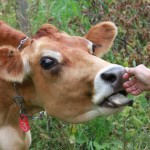 The hay barn, milking barn, cheese room, and cave are all located down a fairly steep hill from the house (which Marjorie and Marian were keen to point out gets shoveled by themselves almost daily during the winter: no snowblowers for these hardy women!) First up was the cheese room and it’s tiny: just enough room for their vat, molds, presses, sinks, and about four people. We’re astonished to hear that these successful cheesemakers have never actually seen another cheesemaking operation and have figured out their recipes and techniques pretty much on their own.
The hay barn, milking barn, cheese room, and cave are all located down a fairly steep hill from the house (which Marjorie and Marian were keen to point out gets shoveled by themselves almost daily during the winter: no snowblowers for these hardy women!) First up was the cheese room and it’s tiny: just enough room for their vat, molds, presses, sinks, and about four people. We’re astonished to hear that these successful cheesemakers have never actually seen another cheesemaking operation and have figured out their recipes and techniques pretty much on their own. 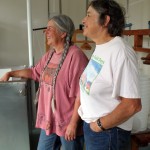
The cows are milked twice a day and cheese is made every Monday and Thursday from November to May. It takes about 1000 pounds of milk to make only 130 pounds of cheese and each cow makes about 1000 pounds of cheese a year. The milk is pumped to the vat via hose, although milk cans were used initially, and once the curds are set, they are stirred by hand and only cooked to about 100 degrees. Excess whey goes out to the garden (or, Marian interjects, gets turned into ricotta if they’re feeling ambitious) and the cheeses are molded and pressed by the women: Marjorie takes care of the 6lb wheels and Marian goes for the 2lb ones. Generally, only two wheels of the entire batch are destined to be aged in their custom-built hillside limestone cave while the others are waxed.
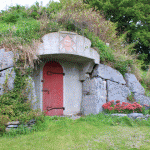
Our last stop before lunch was their cave, built in 2000 by a stonemason friend named Tom. “The cheeses are alive”, said Katy, as we huddled in the entrance and peeked into the small but effective affinage area. There are about eight racks loaded with wheels of cheese at various stages of aging, dotted with increasing layers of grey and green molds. 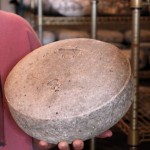
Marjorie discussed their fairly hands-off approach to aging: “It’s the most ancient of arts and they didn’t have a lot of fancy things back then!” While the gorgeous exterior of the cave is crafted from huge slabs of stone, the interior is limestone, a material which doesn’t accumulate mold itself.
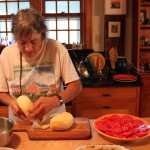 Lastly, we were treated to a localvore’s dream lunch: cheese, roasted tomatoes and peppers, homemade bread, homemade raw cultured butter, and cheese crackers, among other things. Reluctantly, we eventually left, but we left with a much greater knowledge of this particular cheese, its history, and the makers who have been hand-crafting it for so long.
Lastly, we were treated to a localvore’s dream lunch: cheese, roasted tomatoes and peppers, homemade bread, homemade raw cultured butter, and cheese crackers, among other things. Reluctantly, we eventually left, but we left with a much greater knowledge of this particular cheese, its history, and the makers who have been hand-crafting it for so long. 
We left with the feeling that we’d met two people who had found their place in the world and who inspired us with their commitment to sustainability, living off the land, and producing superior quality comestibles. We left with bellies full of this commitment realized. We left inspired. And we left with handfuls of shallots, and for one of us, a huge bunch of rainbow chard.
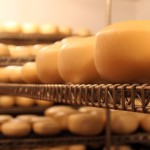
Our heartfelt thanks go out to the people who made this visit possible, most of all to Marjorie and Marian themselves. At one point in the day, Katy declared, “There is love in this house; love of each other and love of food. I feel it.” We all felt it and it’s stuck with us. Thank you, ladies, for sharing your work and home with us!


